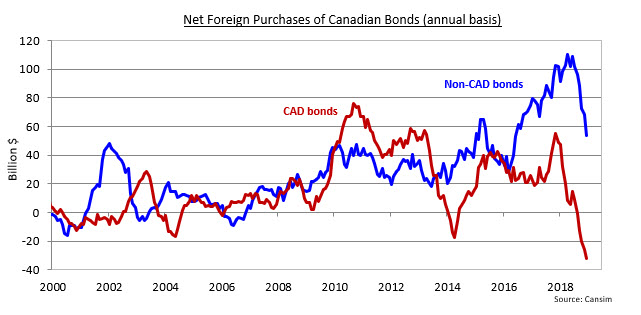Keep connected
Our investment management team is made up of engaged thought leaders. Get their latest commentary and stay informed of their frequent media interviews, all delivered to your inbox.
Jeff Herold
March 8, 2019
Also of note, we learned of a sharp drop in foreign interest in Canadian bonds at the end of 2018. From 2014 to midway through last year international investors made substantial net purchases of Canadian bonds. Much of that interest was for bonds denominated in other currencies, but Canadian dollar (CAD) bonds also met with good demand. More recently, though, foreign demand for Canadian bonds has fallen sharply. Indeed, Canadian dollar denominated issues have actually experienced record divestment over the last twelve months. The fall in international interest likely reflects a number of factors including weak commodity prices, much lower yields than comparable U.S. bonds, and slowing economic growth. Should demand remain low for Canadian bonds, their yields may move closer to U.S. yields.

U.S. economic data was also mixed in February. As in Canada, the unemployment rate in the United States rose slightly, as a higher participation rate offset strong job creation. Consumer sentiment improved with the recent rebound in equity prices and U.S. GDP growth in the fourth quarter of last year, at 2.6%, was surprisingly good. Less positively, retail sales and industrial production were both weaker than expected.
The Canadian yield curve steepened slightly in February as 2-year Canada bond yields edged up one basis point, while 10 and 30-year yields rose 6 and 5 basis points, respectively. The small drift to higher yields also occurred in the United States where benchmark Treasury yields rose 5 to 8 basis points across all maturities.
Our investment management team is made up of engaged thought leaders. Get their latest commentary and stay informed of their frequent media interviews, all delivered to your inbox.